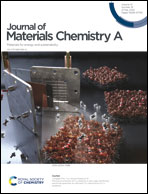Reactive oxygen species regulation and synergistic effect for effective water purification through Fenton-like catalysis on single-atom Cu–N sites†
Abstract
The efficient production and synergistic effect of reactive oxygen species (ROS) are critical in the environmental, chemical and biological fields. Chemical production is suitable for a variety of scenarios and requires no additional equipment, but generates ROS with low efficiency and poor selectivity. In this study, we demonstrated a single-atom Cu–N structure with a unique oxidation state for efficient ROS production and synergistic water purification. The kinetic reaction rate of Cu-SA/H2O2 is 1.23 times higher than that of Fe2+/H2O2 under weakly acidic conditions. Through experiments and density functional theory (DFT) calculations, the Cu–N coordination structure exhibited different adsorption energies for H2O2, peroxydisulfate (PDS) and peroxymonosulfate (PMS), thus enabling highly selective production of different ROS from different catalytic pathways. Efficient and differentiated ROS production allows Cu-SA to be used for the compounding of multiple oxidants, so as to achieve ROS ratio regulation, thereby synergistically and efficiently removing pollutants (COD removal rate increased from 36.8% to 70.7%). Our results highlight single-atom catalyzed efficient ROS production and its synergistic effect for a wide range of potential applications, including environmental remediation.



 Please wait while we load your content...
Please wait while we load your content...